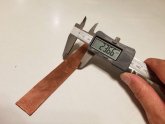The one from Amazon was thin, under 1/16 but I did not need heavy. On Line Metal is 1/8 inch thick. It will make first class buss bar for under 250 amperes.
From On Line Metal; 0.125" x 1" Copper Rectangle Bar 110-H02 - Part #: 4263
pure copper anode; https://www.amazon.com/gp/product/B07PYNRYX3/ref=ppx_yo_dt_b_asin_title_o09_s00?ie=UTF8&psc=1
Currently unavailable. But 1/2" copper water pipe works great if you have a 4" vice and a 4 lb sledge. Plus some of us enjoy the satisfaction of DIY. Of course you should put a hose, or something non conductive, over the exposed copper bar. Which wire does not need. The amount of labor is fairly similar in my book. Putting on lugs vs. flattening and drilling and covering the exposed area.



